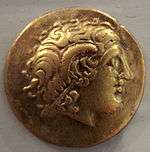Arecomici
The Arecomici (or Volcae Arecomici) were a Gallic tribe attested by the 1st century BC. They dwelled between the Rhône and the Hérault rivers, around Nemausus (present-day Nîmes).[1][2]
Name
The meaning of the name Arecomici is unclear.[1] The Gaulish suffix are- meant 'forward', but the translation of the second element, comici, is unknown.[1] The name Volcae stems from Gaulish uolcos ('hawk').[3]
History
The Volcae Arecomici were probably first officially recognized, or defined, by Rome as an entity around 75 BC.[4] According to anthropologist Michael Dietler, the Roman colonization of the region, which led to the organization of Nemausus as a colonia Latina in the late 1st century AD, "resulted in the ethnogenesis of the Volcae Arecomici out of a formerly fluid coalition of different polities and ethnic groups".[5]
They were indeed part of a political confederation encompassing multiple smaller tribes. In the early first century AD, the Volcae Arecomici were the dominant force of the confederation, ruling over twenty-four subject towns (oppida ignobilia) from their new capital Nemausus.[6]
Economy
Coins with the legend "Volcae Arecomici" (AR/VOLC or VOLC/AREC) are dated to 70 BC, after the Roman conquest and the first emissions of coins at Nemausus.[7]
References
- Nègre 1990, p. 151.
- Dietler 2015, p. 88.
- Delamarre 2003, p. 327.
- Dietler 2015, p. 359.
- Dietler 2015, p. 90.
- Dietler 2015, pp. 88–89.
- Dietler 2015, p. 91.
Bibliography
- Delamarre, Xavier (2003). Dictionnaire de la langue gauloise: Une approche linguistique du vieux-celtique continental (in French). Errance. ISBN 9782877723695.CS1 maint: ref=harv (link)
- Dietler, Michael (2015). Archaeologies of Colonialism: Consumption, Entanglement, and Violence in Ancient Mediterranean France. University of California Press. ISBN 978-0-520-28757-0.CS1 maint: ref=harv (link)
- Nègre, Ernest (1990). Toponymie générale de la France (in French). Librairie Droz. ISBN 978-2-600-02883-7.CS1 maint: ref=harv (link)
